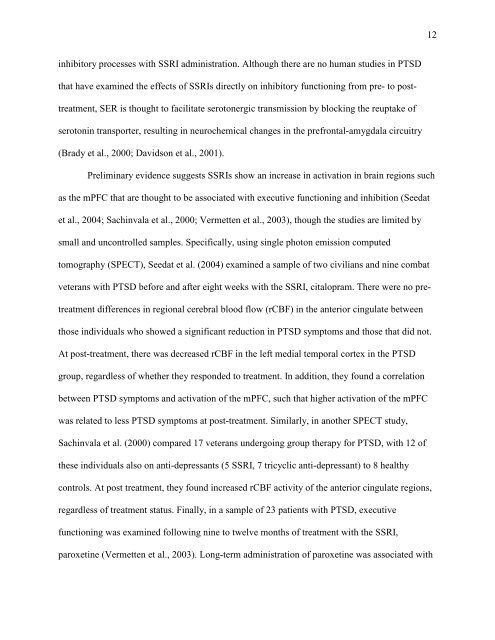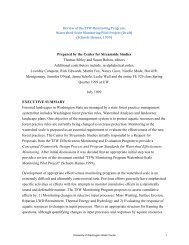Copyright 2012 Aileen M. Echiverri-Cohen - University of Washington
Copyright 2012 Aileen M. Echiverri-Cohen - University of Washington
Copyright 2012 Aileen M. Echiverri-Cohen - University of Washington
Create successful ePaper yourself
Turn your PDF publications into a flip-book with our unique Google optimized e-Paper software.
inhibitory processes with SSRI administration. Although there are no human studies in PTSD<br />
that have examined the effects <strong>of</strong> SSRIs directly on inhibitory functioning from pre- to post-<br />
treatment, SER is thought to facilitate serotonergic transmission by blocking the reuptake <strong>of</strong><br />
serotonin transporter, resulting in neurochemical changes in the prefrontal-amygdala circuitry<br />
(Brady et al., 2000; Davidson et al., 2001).<br />
Preliminary evidence suggests SSRIs show an increase in activation in brain regions such<br />
as the mPFC that are thought to be associated with executive functioning and inhibition (Seedat<br />
et al., 2004; Sachinvala et al., 2000; Vermetten et al., 2003), though the studies are limited by<br />
small and uncontrolled samples. Specifically, using single photon emission computed<br />
tomography (SPECT), Seedat et al. (2004) examined a sample <strong>of</strong> two civilians and nine combat<br />
veterans with PTSD before and after eight weeks with the SSRI, citalopram. There were no pre-<br />
treatment differences in regional cerebral blood flow (rCBF) in the anterior cingulate between<br />
those individuals who showed a significant reduction in PTSD symptoms and those that did not.<br />
At post-treatment, there was decreased rCBF in the left medial temporal cortex in the PTSD<br />
group, regardless <strong>of</strong> whether they responded to treatment. In addition, they found a correlation<br />
between PTSD symptoms and activation <strong>of</strong> the mPFC, such that higher activation <strong>of</strong> the mPFC<br />
was related to less PTSD symptoms at post-treatment. Similarly, in another SPECT study,<br />
Sachinvala et al. (2000) compared 17 veterans undergoing group therapy for PTSD, with 12 <strong>of</strong><br />
these individuals also on anti-depressants (5 SSRI, 7 tricyclic anti-depressant) to 8 healthy<br />
controls. At post treatment, they found increased rCBF activity <strong>of</strong> the anterior cingulate regions,<br />
regardless <strong>of</strong> treatment status. Finally, in a sample <strong>of</strong> 23 patients with PTSD, executive<br />
functioning was examined following nine to twelve months <strong>of</strong> treatment with the SSRI,<br />
paroxetine (Vermetten et al., 2003). Long-term administration <strong>of</strong> paroxetine was associated with<br />
12
















